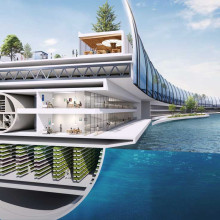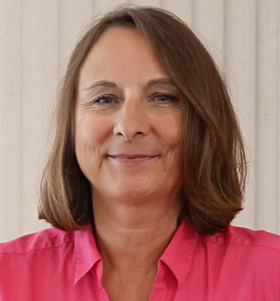Hyperloop News: Low-CO2 lightweight steel for the tubes
- Details
- Hits: 19929
You probably wouldn't notice so much of the beautiful mountain landscape on a trip with the hyperloops in half an hour from Munich to Berlin. Many research institutes are currently working on the idea of Tesla CEO and SpaceX Elon Musk. Tata Steel has a CO2 poor steel developed for the tubes. First test tracks are built. Also the Technical University of Munich (TUM) has started a research program and is building a test track.

Content of the research report
- CO2 poor steel for the Hyperloop
- New steel grade: Zeremis Carbon Lite
- Hyperloop at TUM
- Virgin Hyperloop One
- What is a hyperloop?
CO2 poor steel for the Hyperloop

04.10.2022 | Harden Hyperloop and Tata Steel start the next level of cooperation. The long-term partners signed a contract for the supply of Zeremis Carbon Lite at the Innotrans in Berlin. The steel has a CO reduced by up to 100%2 Footprint verified by DNV (Det Norske Veritas).
Tata Steel works closely with customers and partners to create new, fast and... energy-efficient mobility concepts to realize. One of these technologies is Hardt Hyperloop. Tata Steel has supported the high-speed, sustainable transportation system for people and goods since its inception.
 smart city | Mega buildings, infrastructure, products + technologies
smart city | Mega buildings, infrastructure, products + technologies
The steel is indispensable in the manufacture of the light but strong Hyperloop tubes. The steel tube must withstand the low air pressure inside the tube with the appropriate rigidity. Tata Steel 2020 has teamed up with the Korean steel manufacturer to develop high-quality steel grades Posco merged. The goal is a 50% weight reduction compared to a tube with traditional technology. This requires new steel qualities for spirally welded pipes and completely new pipe designs.
New steel grade: Zeremis Carbon Lite
As early as July 2022, Tata Steel announced the delivery of the first batch of new steel specifically for the Hyperloop. Hardt Hyperloop has now been won as a customer for Zeremis Carbon Lite. The first tubes from the verified CO2 poor steel will be im European Hyperloop Center tested in Groningen in the Netherlands.
"The Hyperloop heralds a new era of mobility. Our goal is to implement a 2050-kilometer Hyperloop network by 100.000. Hyperloop consumes 10 times less energy than road or air traffic. Switching to this technology will help us enable over 1 billion tons of CO annually by then2 save emissions. It therefore made sense to also use steel grades with a lower CO for the material2 footprint," says Mars Geuze, CCO of Hardt.
Following the launch of Zeremis Carbon Lite, Tata Steel continues its journey towards a clean, green and circular future. In order to reduce emissions from steel production on a large scale, the company has committed to switching to green, hydrogen-based steelmaking. Tata Steel is aiming for one Reduction of CO2 Emissions by 35% to 40% by 2030 - when the company commissions its first Direct Reduced Iron (DRI) plant - and targets 2035% less CO by 752 expel. At that point, the company will evolve into a large-scale producer of high-quality green steel. By 2045 they want a CO2 be a neutral steel producer.
Hyperloop at TUM
The Hyperloop should be almost as fast as the sound. Students at the Technical University of Munich (TUM) build unbeatably fast prototypes of the Hyperloop. They have already proven this in international competitions with passenger capsules.
Now the Faculty of Aviation, Space and Geodesy at TUM has one Researchprogram brought to life. It is funded by the Bavarian State Government's Hightech Agenda Bayern. Together with scientists, the students will work on realizing the idea of the super-fast train.
24 meter long test tube planned
 But students are not only interested in speeds. In their project, they also investigate how the Hyperloop can prove to be safe, affordable, and sustainable Means of transport of the future can be realized. Among other things, they will develop a suspension system for the capsules and a prototype of the test tube made of ultra-high-strength concrete.
But students are not only interested in speeds. In their project, they also investigate how the Hyperloop can prove to be safe, affordable, and sustainable Means of transport of the future can be realized. Among other things, they will develop a suspension system for the capsules and a prototype of the test tube made of ultra-high-strength concrete.
In a first phase, which will run for two years, system analyzes of the feasibility and potential of the Hyperloop concept in Europe will be carried out in the first phase. This has a duration of two years and also includes the development and testing of relevant technologies such as the 24-meter test track.
It is being built on the grounds of the Ludwig Bölkow Campus Taufkirchen / Ottobrunn together with a prototype capsule im Scale 1: 1. The expertise of the TUM departments of materials science, civil engineering and drive systems will be incorporated into the research work program.
Full-size prototype
Professor Agnes Jocher leads the research program. She has held the professorship for Sustainable Future Mobility at TUM since the beginning of July 2020. “The Hyperloop has the potential to offer a fast, electric alternative on medium-long distances and thus enable more sustainable and environmentally friendly transport,” explains Prof. Jocher. “But more research is needed to test this assumption. For example, the production and the construction of the system must also be included. "

Gabrielle Semino, part of the Hyperloop team since 2017, participated in the three competitions in Los Angeles. He is now a research associate on the program. “The competition was about prototypes that were mainly designed for speed,” he explains. “In this research project we are now following a scalable overall systemthat is influenced by all aspects such as profitability, sustainability and safety. However, the knowledge we have gathered over the years in the matter and in prototype construction will definitely be indispensable for us, ”comments Mr. Semino.
Under the aspect that the planned demonstrator, unlike the previous prototype, is as big as a possible future Passenger capsule The scientist explains: “Our last prototype weighed less than 70 kilograms, now we are at several tons.” The test tube, including the foundation, should be around 4 m high. First, the Hyperloop concept is to be validated with the demonstrator. In a later phase of the project, a longer test track for further tests is planned.
The hyperloop in animation
Students from all over the world have already appeared three times with their prototypes for the cabin capsule, the so-called Under, against each other. The TUM prototype raced to the finish line as the fastest three times and was able to leave the competition far behind in every race. The current record was set by the students at the last competition in July 2019 with 482 kilometers per hour (km / h). The team is presenting its fourth pod here.
Not-a-Boring Competition by Elon Musk

17.07.2020/XNUMX/XNUMX | In the student initiative TUM Boring - Innovation in Tunneling Over 60 student members from various Munich universities have come together to win Elon Musk's Not-a-Boring Competition. The TUM Boring members combine skills from mechanical engineering, electrical engineering, mechatronics, civil engineering, physics, IT, TUM business administration and much more.
The Not a Boring Competition follows on from the previous project TUM Hyperloop. With his The Boring Company, Elon Musk wants to accelerate tunnel construction and make it cheaper. If you consider that it has taken up to eight weeks to drill a kilometer of tunnel, that is a goal here. A prototype for a tunnel boring machine is to be developed by spring, with which a tunnel 30 m long with a diameter of 0,5 m can be built as quickly as possible. In the tunnel, which is to be built in California, there will also be a drivable surface that will be used for the first time in a test drive with a Tesla.
14 times faster tunnel boring machine
 For the Hyperloop Tunnel Bore Challenge, TUM Boring competes against teams from all over the world. The students are building one Tunnel boring machinewhich is supposed to drill up to 14 times faster than is currently the case in tunneling. The preliminary draft has already been accepted and the team has moved into the second round.
For the Hyperloop Tunnel Bore Challenge, TUM Boring competes against teams from all over the world. The students are building one Tunnel boring machinewhich is supposed to drill up to 14 times faster than is currently the case in tunneling. The preliminary draft has already been accepted and the team has moved into the second round.
TUM Boring has already developed a working prototype with a diameter of 20 cm that has drilled a few meters of tunnel for the future Hyperloop tube. Given the ongoing competition, Co-Founder Jonah Rossmann do not go into too much technical detail of the development, but emphasizes that automation is of central importance for the mentioned efficiency increases. In comparison, many processes in today's tunneling technology would still require manual intervention.
Main technologies in tunneling

Generally there are two Main technologies in tunneling. For larger diameters from approx. 3 to 4 m, so-called "segments" are installed. These are individual pipe segments that are set manually using a joystick. This requires a great deal of time. The so-called “pipe jacking” process is used for smaller diameters. Due to the reduced tunnel cross-section, lower forces act here. The pipes can be driven by a jacking system such as hydraulic cylinders be pressed into the ground. When a pipe segment is completely in place, the cylinders retract and the process starts all over again. A crane is usually used for this.
The Prototyp the TUM Boring itself does not yet represent the technical concept, but is based on the existing technologies. It was built to gain even more practical experience of the behavior and performance of the various technical components.
For a Test drilling Erdweg was chosen about 40 km north of Munich. Legal approval was required for the project in the garden of the parents of the technical project manager. In addition, the geology there is softer because the area is outside the so-called Munich gravel plain. The geological conditions of the Danube-Isar hill country are probably better to compare with the conditions to be expected in California.
Virgin Hyperloop One

The US company Virgin Hyperloop One is also working on the implementation of the Hyperloop concept by Elon Musk. Virgin Hyperloop One's founder is the visionary Richard Branson. In May 2016, Virgin launched the Hyperloop One Global Challenge. Teams around the world were asked to propose feasible routes.
In 2017, ten routes were selected for the tender from among 35 nominated route proposals. They are now to be built. Unfortunately, Germany is not there, but made it to the semifinals with a connection between Hamburg and Berlin.
First Hyperloop test track at Virgin
Virgin Hyperloop One has built a Hyperloop route in the form of an initial test tube in the Nevada desert. Of the devloop achieved a speed of 2017 kilometers per hour for the first time in 387.
General technical knowledge
Hyperloop is the concept of one Super express trainsracing through a system of pipes. Tesla and SpaceX CEO Elon Musk first presented his vision in 2013. The idea behind it is a ground transportation system for passengers and freight at ultra-high speed. It should be faster than an airplane and cheaper than the train over a distance of up to 1200 kilometers.
The Hyperloop consists of two adjacent driving tubes in which a Partial vacuum is produced. The tubes connect various traffic junctions in large metropolitan areas. Through the partvacuum the high-speed train is "shot" through the tube at almost the speed of sound.
The pressurized vehicles are called pods. The contactless Floating or Power Typesystem and the low air resistance, the ultra-high speeds are only possible. With the Elon Musk concept, travel times for medium-range distances can be reduced considerably. The train from Berlin to Munich only takes half an hour. The express train also aims to be completely climate-neutral with fully electric operation.
You might also be interested in...

smart city | Mega buildings, infrastructure, technologies

Angela Struck is editor-in-chief of the development scout and freelance journalist as well as managing director of Presse Service Büro GbR in Ried.
